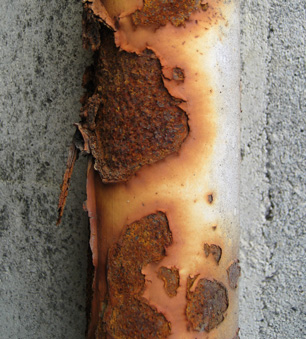Corrosion
| EPA Secondary Drinking Water Standard |
Non-Corrosive |

“Nature is constantly striving to reach balance and equilibrium. Corrosion is the natural deterioration of materials by chemical and physical interaction with the external environment. Man creates, and nature destroys; this is the essence of corrosion.” — Greg Reyneke. Water Conditioning and Purification Magazine, April 2010.
Symptoms
-
Yellow, green, orange or blue coloring of water. These are symptoms of metallic corrosion.
-
Yellow, green, orange or blue coloring of tubs, toilet bowls and tanks. These are symptoms of metallic corrosion.
-
Tastes and Odors. Corrosion by iron, copper, and brass make bitter or metallic taste and sometimes odors.
-
Sediment and particulate. Rust accumulates as reddish-brown sediment.
-
Leaks. Dripping water and crustaceous deposits on the outside of pipes are signs of corrosion within.
-
High flow rates. “When flow velocity becomes excessive, pitting is the inevitable result.”
-
High TDS. Over 500 ppm TDS, the potential for corrosion increases.
-
Low pH. As pH goes below 7.0, the potential for pitting and corrosion increases.
-
High water temperature. Warm water speeds up chemical reactions and also liberates dissolved CO2, which contributes to corrosion.
-
Suspended solids can act as sandpaper inside pipes and appliances. Dissimilar metals in contact. Galvanic action is the most significant single contributor to metallic corrosion.
-
Chlorine and Chloramine. These common disinfectants lead to the breakdown of both metals and rubber materials. Chloride. Chlorides are the enemy of stainless steel.
-
Biofilm. Biofilm grows in all water systems and it encourages corrosion.
Causes
Water Treatment for Corrosion
Treatments for corrosion, obviously, are many, since the causes are many. Some common treatments are increasing pH, reducing chlorides (reverse osmosis), reducing chloramines and chlorine (carbon filtration), turning down the hot water heater, filtering out excessive sediment, or decreasing the demand for flow through the piping.
Source: Water Conditioning and Purification Magazine, April 2010. Photo: WikiMedia, author: Vsolymossy
Site Index
Filtration Systems
- Aeration for Iron & Sulfide
- Backwashing Filters
(whole house & well units)
- Chlorine & Chemical Injectors
- Countertop Water Filters
- Garden Hose Filters
- Reverse Osmosis, Residential
- Reverse Osmosis, Commercial
- Shower Filters
- Specialty Filters
- Ultraviolet Systems
- Undersink Filters
- Water Softeners
- Whole House Filters
Cartridges
Parts
- Replacement Parts
- Faucets
- Filter Media
- Fittings
- Housings
- O-rings
- Pumps
- Pura UV
- R.O. Parts
- R.O. Tanks
- R.O. Booster Pump
- VIQUA UV